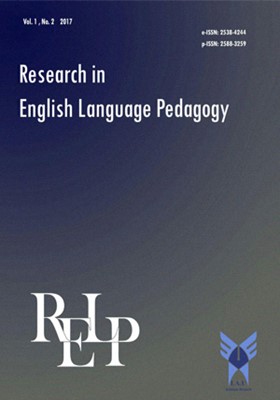EFL Male and Female Learning Styles and Multiple Intelligences A Case of Iranian EFL University Students
Subject Areas : Research in English Language Pedagogy
1 - Department of Foreign Languages,
Isfahan University, Iran
Keywords:
Abstract :
Armstrong, T. (1997). The myth of the ADD child: 50 ways to improve your child’s
behavior and attention span without drugs, labels, or coercion. New York:
Plume.
Armstrongm, T. (1988). Learning differences—not disabilities”. Principal, pp.
34–36.
Armstrong, T. (1999a). 7 kinds of smart: Discovering and identifying your
multiple intelligences— Revised and updated with information on two new kinds of smart. New York: Plume.
Armstrong, T.(1999b). ADD/ADHD alternatives in the classroom. Alexandria,
VA: ASCD.
Armstrong, T. (2003). You’re smarter than you think: A kid’s guide to multiple intelligences. Minneapolis, MN: Free Spirit Publishing.
Armstrong, T. (2008). Multiple intelligences in classroom. (3 rd edition).
Alexandria, Virginia, USA.
Beloff, H. (1992). Mother, father and me: Our IQ. The Psychologist, pp.5,
309–311.
Bennett, M. (1996). Men’s and women’s self-estimate of intelligence. Journal of
Social Psychology, pp.136, 411–412.
Bennett, M. (1997). Self-estimates of ability in men and women. Journal of
Social Psychology,pp. 137, 540–541.
Bennett, M. (2000). Gender differences in the self estimation of ability. Australian
Journal of Psychology, pp.52, 23–28.
Byrd, M., & Stacey, B. (1993). Bias in IQ perception. The Psychologist, pp 6, 16. Christison, M. A. (1998b). An introduction to multiple intelligence theory and
second language learning. In J. Reid (Ed.), Understanding learning styles in the second language classroom Upper Saddle River, NJ: Prentice Hall
Regents, pp. 1-14.
Furnham, A. Parent estimates of their own and their children’s multiple
intelligences. British Journal of Developmental Psychology, 2000, pp. 18,
583–594.
Furnham, A. (2001). Self-estimates of intelligence: Culture and gender differences
in self and other estimates of general (g) and multiple intelligences. Personality
and Individual Differences, pp.31, 1381–1405.
Furnham, A., & Baguma, P. (1999). A cross-cultural study from three countries
of self-estimates of intelligence. North American Journal of Psychology, pp.
1, 69–78.
Furnham, A., Clark, K., & Bailey, K. (1999a). Sex differences in estimates of
multiple intelligences. European Journal of Personality, pp.13, 247–259. Furnham, A., & Fong, G. (2000). Self-estimated and psychometrically measured
intelligence: A cross-cultural and sex difference study. North American
Journal of Psychology, pp. 2, 191–199.
Furnham, A., Fong, G., & Martin, N. (1999b). Sex and cross-cultural differences
in the estimated multifaceted intelligence quotient score for self, parents
and siblings. Personality and Individual Differences, pp. 26, 1025–1034. Furnham, A., & Gasson, L. (1998). Sex differences in parental estimates of their
children’s intelligence. Sex Roles, pp.38, 151–162.
Furnham, A., Hosoe, T., & Tang, T. (2001). Male hubris and female humility? A
cross-cultural study of ratings of self, parental and sibling multiple
intelligence in America, Britain, and Japan. Intelligence, pp. 30, 1001–115. Furnham, A., Rakow, T., & Mak, T. (2002a).The determinants of parents’ beliefs
about the intelligence of their children: A study from Hong Kong.
International Journal of Psychology. pp, 37, 343–352.
Furnham, A., & Rawles, R. (1995). Sex differences in the estimation of
intelligence. Journal of Social Behavior and Personality, pp. 10, 741–745. Furnham, A., & Rawles, R. (1999). Correlations between self-estimates and
psychometrically measured IQ. Journal of Social Psychology, pp.139,
405–410.
Furnham, A., Wytykowska, A., & Petrides, K. V. (2005).Estimates of multiple
intelligences: A study in Poland. European Psychologist, 10, 51–59. Gardner, H. (1993a). Frames of mind: The theory of multiple intelligences—10th
anniversary edition. New York: Basic Books.
Gardner, H. (1999). Intelligence reframed: Multiple intelligences for the 21st
century. New York: Basic Books.
Graf, S., Kinshuk, & Liu, T.-C. (2009).Supporting Teachers in Identifying
Students’ Learning Styles in Learning Management Educational Technology
& Society, 12 (4), 3–14.
Hogan, H. (1978). IQ self-estimates of males and females. Journal of Social Psychology, pp,106, 137–138.
Keobke, K. (1998). Computers and collaboration: Adapting CALL materials to
different learning styles. In J. Reid (Ed.), Understanding learning styles in the second language classroom Upper Saddle River, NJ: Prentice Hall Regents,pp.
46-51.
Lazear, D. (1999). Multiple intelligence approaches to assessment. Tucson, AZ:
Zephyr.
Pedrosa de Jesus, H., Almeida, P. & Teixeira-Dias J.J. (2007). Where learners’
questions meet modes of teaching: A study of cases. Research in Education,
78, pp1-20.
Reid, J. (1987). The perceptual learning style preferences of ESL students. TESOL
Quarterly, , 21, 87-111.
Silver, H., Strong, R., & Perini, M. (1997).Integrating learning styles and multiple
intelligences. Educational Leadership, 55(1), 22–29.


